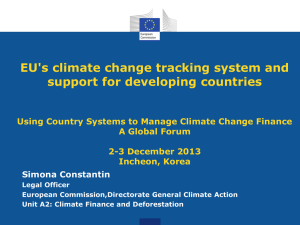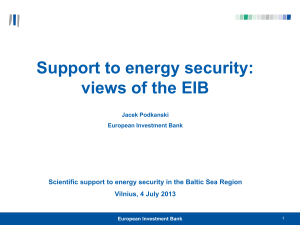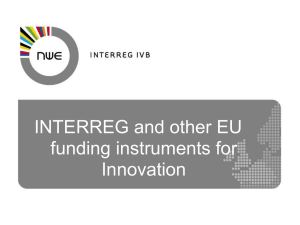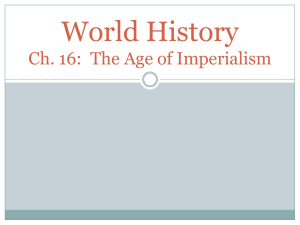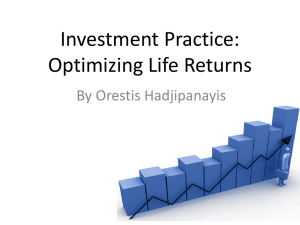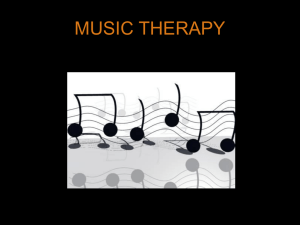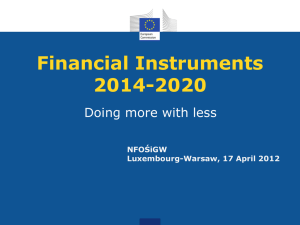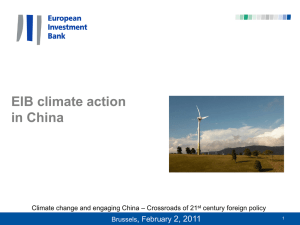EU Financial Instruments
advertisement
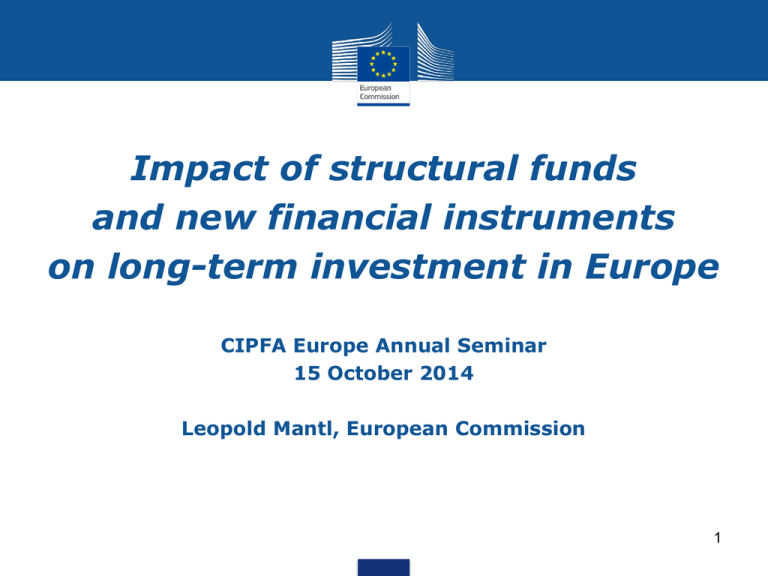
Impact of structural funds
and new financial instruments
on long-term investment in Europe
CIPFA Europe Annual Seminar
15 October 2014
Leopold Mantl, European Commission
1
Challenges for long-term financing
2
Europe's infrastructure challenge
Annual investment in infrastructure in Europe is
estimated at EUR 450bn (3.6% of GDP)
Infrastructure investment needs in European
transport, energy and broadband networks by 2020:
Between EUR 1,500bn and EUR 2,000bn
National government and EU budgets are limited
More private financing needed
Long tenor bank financing is constrained
Need to massively develop non-bank
financing
3
Europe's research challenge
Debt:
• 150 000 to 500 000 innovative SMEs originating
bankable operations not supported by the market.
Funding gap: between €112 bn and €375 bn.
• For innovative midcaps the average total annual
demand for debt financing is estimated to be €250.5
billion for debt financing.
Equity:
• For SMEs, financing gap is some €800 million per year.
• For innovative midcaps, the average total annual
demand (2011 figures) for equity finance is estimated
to be just under €39 billion for equity
4
Europe' SME Challenge (I)
28 million SMEs in the EU:
Share of total number of companies
account for more than 99% of
all companies
employ 66.5% of all privatesector workforce
Micro-businesses dominate
employment in some countries: Italy
(48%) and Greece (57%)
Very flexible
Stable employer, source of organic
growth and innovation
Source: Eurostat, Commission Communication on
Modern SME policy for Growth and Employment
5
Europe's SME Challenge (II)
Europe moves out of the crisis, but supply of credit remains
constrained as banks deleverage, accumulate capital and repair
balance sheets.
Continuing market gaps and deficiencies in debt and equity markets
for financing of enterprises, and especially SMEs
75% of SMEs dependent on external financing
'access to finance' the second most pressing problem for
Eurozone SMEs, right after getting customers
venture capital fundraising and investment levels at one
quarter of 2006 levels
6
Europe's response to the challenge
Outlined in Commission Communication on long term financing
(COM/2014/0168 final) and Commission Political Guidelines
Mobilising private sources of long term financing (banks,
insurance companies, pension funds, private savings accounts)
Developing European capital markets
Enhancing the sider framework for sustainable finance (corporate
governance, accounting standards, tax and legal environment)
Improving SME access to finance
Making better use of public funding to obtain EUR 300
billion in additional investments
•
EU budget
•
EIB/EIF
•
National promotional banks, export credit agencies
7
The role of the Union budget
8
Europe 2020 - The basis for the MFF 2014-20
9
The Europe 2020 strategy and the EU budget
Improved alignment of funding policies and financing
instruments:
Thematic concentration of investments on the priority objectives
of the Europe 2020 Strategy
Specific objectives, targets and monitoring
Conditionalities
Result-orientation and performance reserves
Increased use of innovative financial instruments
(enhancing the leverage effect)
10
Comparison of ceilings 2000-2020 (EUR bn)
EUR bn (2011 prices)
160,0
MFF '00-'06: EUR 878.5 bn
MFF '07-'13: EUR 993.6 bn
COM '14-'20*: EUR 1033.2 bn
150,0
EUR 1.0 bn
MFF 2014-2020 : EUR 959.9 bn
140,0
EUR 5.6 bn
'07-'13 average
EUR 141.9 bn
'14-'20 average
EUR 137.1 bn
130,0
Committment ceiling of
MFF 2000 -2006 for EU -15/25
N.b.: For better comparability, the
level of the COM proposal in this
depiction does not include ITER,
GMES and the Agri-Reserve.
If they were included, the COM
proposal would read 1045.3 bn
and the difference with the MFF
2014-2020 would be 85 instead
of the 73 bn shown above.
Committment ceiling of
MFF 2007 -2013 for EU -27
120,0
Committment ceiling of
updated COM proposal for MFF
2014 -2020 for EU -28 (June 2012)*
'00-'06 average
EUR 125.5 bn
110,0
Commitment ceiling of MFF 2014-2020
100,0
2000
2001
2002
* ITER and GMES outside the MFF
2003
2004
2005
2006
2007
2008
2009
2010
2011
2012
2013
2014
2015
2016
2017
2018
2019
11
2020
Comparison of ceilings 2000-2020 (% GNI)
% of EU GNI
1,30%
'93-'99 average 1.25%
1,25%
1,20%
1,15%
1.27% of GNP ≡ 1.24% of GNI excl.
1.23% of GNI incl. FISIM
f GNP
1.27% o
to
%
0
from 1.2
Own
OwnResources
Resourcesceiling
ceiling
Commitment
ceiling
Payment ceiling
of of
Financial
FinancialFramework
Framework
'93-'99 average 1.19%
'07-'13 average 1.12%
'00-'06 average 1.09%
1,10%
1,05%
'93-'99 average
1.06%
'00-'06 average 1.06%
Payment ceiling of
Financial Framework
Payments actually
executed/appropriations*
Payments actually
executed/appropriations*
'07-'13 average 1.06%
'14-'20 average 1.00%
1,00%
0,95%
'00-'06 average
0.94%
'14-'20 average 0.95%
0,90%
0,85%
* excluding expenditure financed by assigned revenue
12
The EU intervention model – new MFF
half of the budget and EIB are growth related (together 1.0% of
GDP)
EU Budget
EIB
(size ~ 1% GDP EU p.a.)
(lending volume ~0.55% GDP p.a.)
EU budget 2014 – 2020: € 960 bn (MFF Multiannual Financial Framework)
Administration
Foreign
6%
Policy
6%
Agriculture &
Rural
Development
41%
Other
2%
Competitiv
eness
13%
EIB as of 2013 (€ 70 bn p.a.) € 50 bn
normal programme and € 20 bn additional
programme for 4 objectives (innovation
and skills, SMEs, clean energy and modern
infrastructure)
Cohesion
34%
13
Competitiveness (Heading 1a)
+ EUR 34 billion
Youth Employment Initiative, EUR 6 billion.
14
EU budget – types of intervention
Grant funding (non-reimbursable)
Introducing financial mechanisms which will enable
the mobilisation of third-party funds as leverage on
EU funds.
• PPP
• Financial instruments
• Trust funds
15
Financial instruments
16
What are EU Financial Instruments?
Equity/risk capital, e.g. venture capital to SMEs with high
growth potential or risk capital to infrastructure projects
Guarantees to financial intermediaries that provide lending
to e.g. infrastructure projects, SMEs, persons at risk of
social exclusion
Other risk-sharing arrangements with financial
intermediaries in order to increase the leverage capacity of
the EU funds
or a combination of the above with other forms of EU
financial assistance in single instruments (e.g. grants)
17
EU Financial Instruments: Why?
3 types of benefits
Policy impact – effective way of delivering on policy objectives,
financial intermediaries pursue EU policies
Multiplier effect – multiplication of scarce budgetary resources by
attracting private resources to financing public policy objectives
Institutional know-how – EU can use the resources and expertise of
financial intermediaries
As a result: Financial instruments are a recognised political
priority (Europe 2020 Strategy, Communication on a Budget for
Europe 2020, instruments for the 2014-2020 MFF)
18
EU Financial Instruments: When?
Guiding principles:
Financial instruments and grants are complementary financing tools.
Financial Instruments:
Address market gaps or sub-optimal investment situations
in economically viable projects
Funding gaps e.g. due to general economic uncertainty, high
business/innovation risk, high transaction costs, asymmetric
information
Ensure EU value added
Effective targeting of policy goals
Catalytic effect on existing similar MS schemes or private
investment, no crowding out
Provide leverage
Attract private investment greater than EU contribution
19
Lessons learned
Importance of capitalising on best practices and more
consistency in governance, supervision and control of future
financial instruments.
Need to strike the right balance between the EU's legitimate
reporting and supervision needs and attractiveness for market
participants.
Need for smart design:
Addressing market needs;
Alignment of interest with intermediaries, rather than
multiplication of control requirements, integrated assurance
building;
Market distortions to be at necessary minimum.
20
Future: Smarter Design
Streamlined implementation modalities with standardised
contractual arrangements including management structures,
reporting, fees, etc. Simplification.
Continuing to offer both pro- and countercyclical
instruments to respond to market needs.
Increased effectiveness and efficiency:
Fewer instruments with larger volumes, ensuring critical mass;
Enhanced alignment of interest with financial intermediaries
(through fees, incentives);
Single entry point;
Possibly greater leverage thanks to risk-sharing with IFIs (debt
instruments with first-loss-piece coverage;
Coordination with the Structural Funds;
Minimisation of overlaps.
21
EU financial instruments
2014-2020: State of Play
The New Regulatory Environment
3
EU financial instruments
2014-2020: State of Play
Internal Instruments/1: Overview
Funding Programme
Responsible
DG
Indicative Amount
COSME
ENTR
EUR
Horizon 2020
RTD
EUR 2.55 billion
Erasmus + (Student Loan
EAC
EUR 517 million
Connecting Europe
Facility
MOVE
EUR 3.3 billion
LIFE (PF4EE + NCFF)
ENV-CLIMA
EUR 140 million expected
EaSI
EMPL - ECFIN
EUR 193 million expected
Guarantee facility)
1.38
billion
EFG/717 mio LGF)
All these instruments are managed by the EIB – EIF
11
(662
mio
EU financial instruments
2014-2020: State of Play
Internal Instruments/2: types of instruments
12
Infrastructure: two level approach
Trans-European level: Projects of Common Interest
Transport: Trans European Networks (TEN-T)
Energy: Trans European Networks (TEN-E)
Telecommunications and ICT services
The Connecting Europe Facility: EUR 33bn ('14-'20)
Regional level: Structural funds
Funding of infrastructure projects: Transport, Energy
networks, Energy efficiency, Urban development, ICT
But also other areas: Research, Education, Competitiveness
Total Structural fund envelope: EUR 366bn ('14-'20)25
Project Bonds: Funded vs. Unfunded Solution
Funded credit enhancement - Mezzanine loan
Project
Bonds
Target
rating
SPV
Project
Costs
EIB
Sub-debt
Equity
Public bond issue
or
private
placement
Project
Bond
Investor
20% of bond
issue max
Unfunded credit enhancement - Guarantee
Project
Bonds
Public bond issue
or
private
placement
Project
Bond
Investor
Target
rating
SPV
Project
Costs
EIB
Guarantee
Equity
EIB Sub-debt participation can be combined with different types funding sources (bonds and other senior loans)
EIB Unfunded Sub-debt participation can be flexibly used and structured in order to ensure target rating.
26
20%
max
COSME Loan Guarantee Facility
Provides a frame
financial intermediaries can create products suitable
for their particular markets
Capped portfolio guarantees
free of charge
Strict focus on additionality
guarantees focus on transactions with a higher risk
profile
Wide range of interventions
Working capital, investment loans, subordinated
loans, bank guarantees, leasing
Duration
min. 12 months (transaction) – max. 10 years
(guarantee)
Amount
≤ € 150,000: for any type of SME
> € 150,000: under conditions
27
Member
States
Entrusted entity
Joint EC/ EIB SME initiative
Application to call for expression of interest; demand
driven
€
€
€
Financing
28
Accounting rules
Accounting officer of the Commission adopts
accounting rules, based on IPSAS
Financial instruments are covered by Accounting
Rule 11
Financial data to be provided by entrusted
entities according to a standardised reporting
format
29
Conclusions
In addition to a regulatory intervention, the
Union can support long term financing through
its budget
Given that the Union budget is limited in size
compared to the EU GNI, it is important to
leverage EU funds
Well designed Financial instruments are an
efficient way to do so
30
